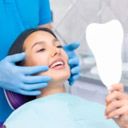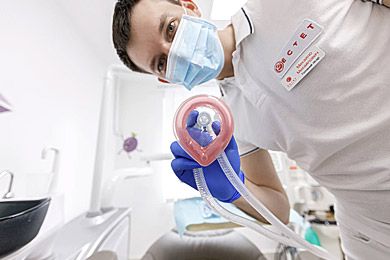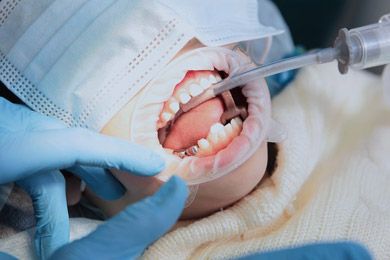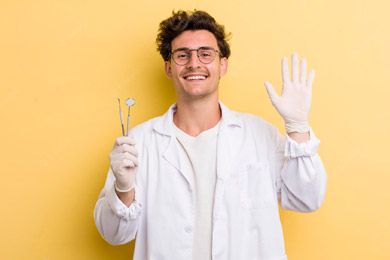General anaesthesia is a good choice for dental treatments to be comfortable for both the patient and the dentist. The anaesthetist and team take care of the patient throughout the treatment. It is performed in the operating theatre environment.
Dentist visits are not as comfortable for every individual. Some people are extremely afraid of dental treatment. These people have a phobia of dentists. They avoid treatment as much as possible. They do not allow the dentist to work during dental treatment because of these phobias. In this case, it will be possible for both the patient and the dentist to perform the treatment under general anaesthesia.
It is important to protect the oral and dental health of disabled people. Therefore, dentist visits should be done regularly. If disabled people need dental treatment, local anaesthesia or general anaesthesia solutions are decided according to their psychological state. If the patient's psychology does not allow dental treatment under local anaesthesia, general anaesthesia is preferred.
Some patients may need many different dental treatments. Patients may request that their treatment be completed in one visit. Dental treatments can take a long time to complete and can cause serious discomfort for the patient who has to keep their mouth open. In such cases, patients may prefer to have dental treatment under general anaesthesia.
If the patients using blood thinners need major surgical treatment, it is recommended to be treated under general anaesthesia. Because bleeding is controlled during general anaesthesia and a safer treatment environment is provided.
General anaesthesia is becoming more common in oral, dental and maxillofacial surgery. Because the treatments such as treatment of broken jawbone, treatment of large cysts and tumours, treatment of cleft lip and palate and orthognathic surgery cannot be performed with local anaesthesia.
Patients may rarely be allergic to local anaesthetics. Two types of allergy are known: early-type and late-type. Early-type allergy occurs within about 60 minutes after the drug is administered. Itching, blistering and redness in a different area from where the drug is applied may be an indication of allergy. Life-threatening symptoms such as shortness of breath, low blood pressure, vomiting and swelling of the small tongue may also be observed. Late-type allergy starts a few hours after the drug is administered and reaches its maximum level after 72 hours. Symptoms such as swelling, redness and itching in the anaesthetised area may be indicative of late-type allergy. In such cases, it is important to visit an allergy specialist. Patients who develop allergies to local anaesthetics may prefer dental treatment under general anaesthesia.
During dental treatment, you must remain still and follow the dentist's instructions. Patients who cannot fulfil these conditions may have maladjustment. It is usually seen in children and makes treatment impossible. However, both adults and children may have a gag reflex. The gag reflex will cause a disturbance of compliance. It will be convenient to perform the treatment under general anaesthesia.
It is the preparation of patients for dental treatments in a sleeping state by applying intravenous drugs and gases. General anaesthesia should be performed in the operating theatre.
The anaesthesiologist is present at the patient's bedside throughout the operation, controls vital functions and creates a safe treatment environment. The anaesthetist monitors the depth of sleep and administers medication during the operation in a controlled manner. Thus, it is ensured that the patient does not wake up during anaesthesia. Although it is very rare, the patient may wake up during the procedure. Anaesthesia works as long as the operation continues.
It is important that the patient follows the preparation procedure before the operation. Medical tests requested by the anaesthesiologist must be performed by the patient. The anaesthesiologist will give approval according to the test results.
People can be allergic to anaesthetics, just as they can be allergic to any medication. Allergies to anaesthetic drugs are very rarely encountered. The anaesthetist is very well trained in this area and will intervene if an allergy appears. When allergy starts, the anaesthesiologist continues the process with a different group of anaesthetics.

The cost of general anaesthesia may be relatively cheaper in Turkey.
| Dental Treatment Prices in Turkey | |
|---|---|
| Consultation | Free |
| Examination | Free |
| General Anaesthesia | £ 345 |
| Sedation | £ 260 |
If dental treatment with general anaesthesia is decided, information about the general health status of the patient is obtained and some tests are requested. When the general health condition and analyses are found to be appropriate, the patients are taken into treatment. The patient is informed about what to do before general anaesthesia. The operation is started if the patient has completely fulfilled the preoperative stage.
The patient is prepared in the clinical environment, a surgical gown is put on, an intravenous line is opened and the serum is connected. The patient is transferred from the stretcher to the operating table. Various medical instruments are attached to the patient to monitor vital functions throughout the operation. Oxygen is administered to the patient with a mask, and then drugs that will not make the patient feel pain, put the patient into a special sleep state and relax the muscles are given to the patient intravenously.
Once the patient is asleep, a tube is inserted into the windpipe and anaesthetic gases mixed with oxygen are administered. Anaesthesia continues as long as anaesthetic drugs are administered, the process ends when the drugs are discontinued and the patient wakes up. The anaesthesiologist and his/her team are constantly with the patient during this process and monitor the clinical findings of the patient during the treatment and intervene when necessary.
After the treatment is completed, the patient is awakened. All anaesthetic drugs are discontinued, the patient is awakened and all vital functions are restored. Afterwards, the patient is kept for a while to monitor the effect of the drugs used and to control the pain. After the parameters such as respiration, pulse and blood pressure are stable, the patient is sent to the observation room with the approval of the anaesthesiologist. The patient rests until the effect of anaesthesia wears off and is checked by the anaesthesia team. The patient who has completely recovered from the anaesthesia effect is discharged.
We do our best to ensure that our patients' dental treatments are comfortable. Keeping their satisfaction at the highest level is very important to us.
Please fill the form, we will contact to you for online dental consultation.
Please fill the form, we will contact to you for online dental consultation.








